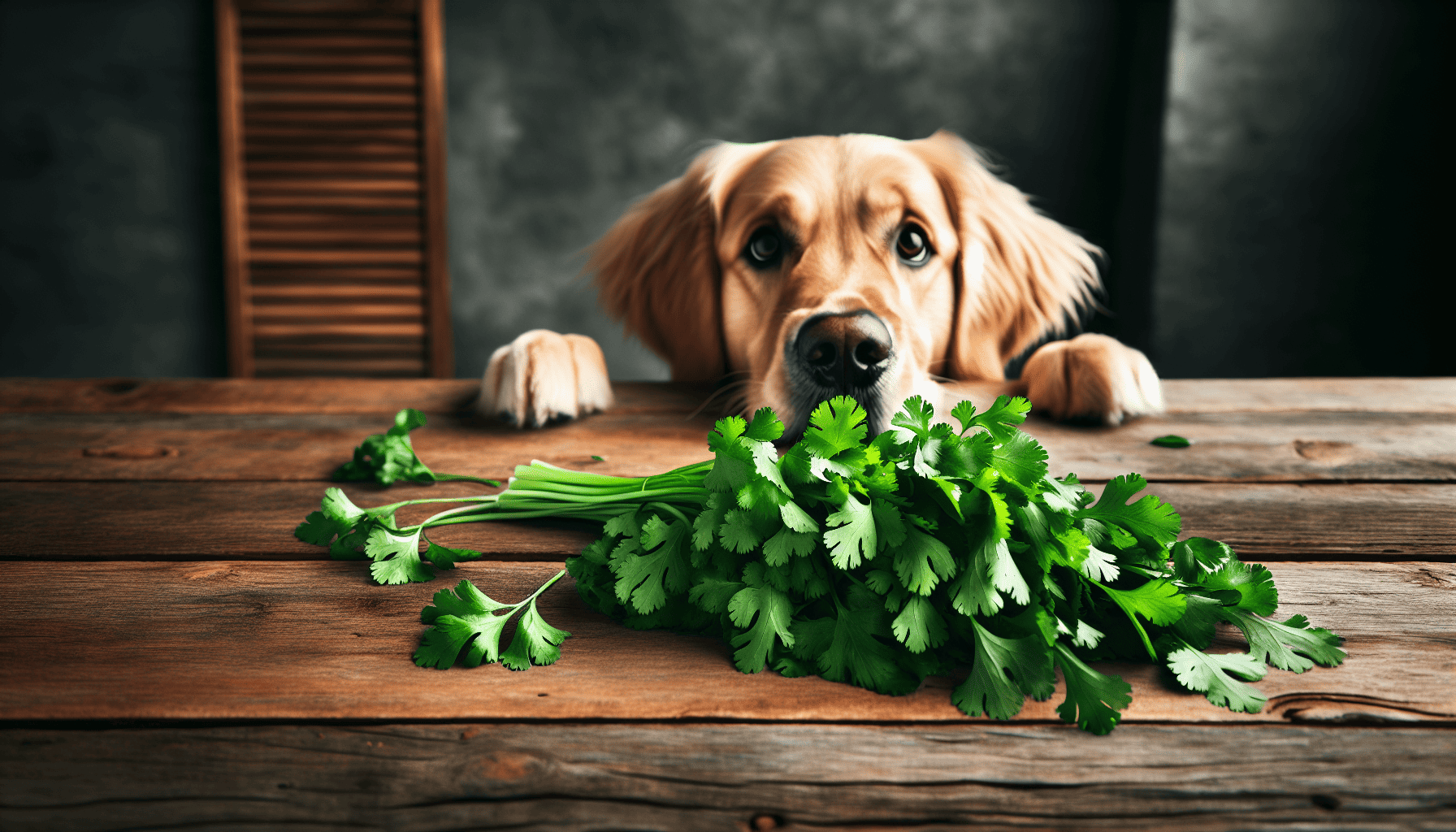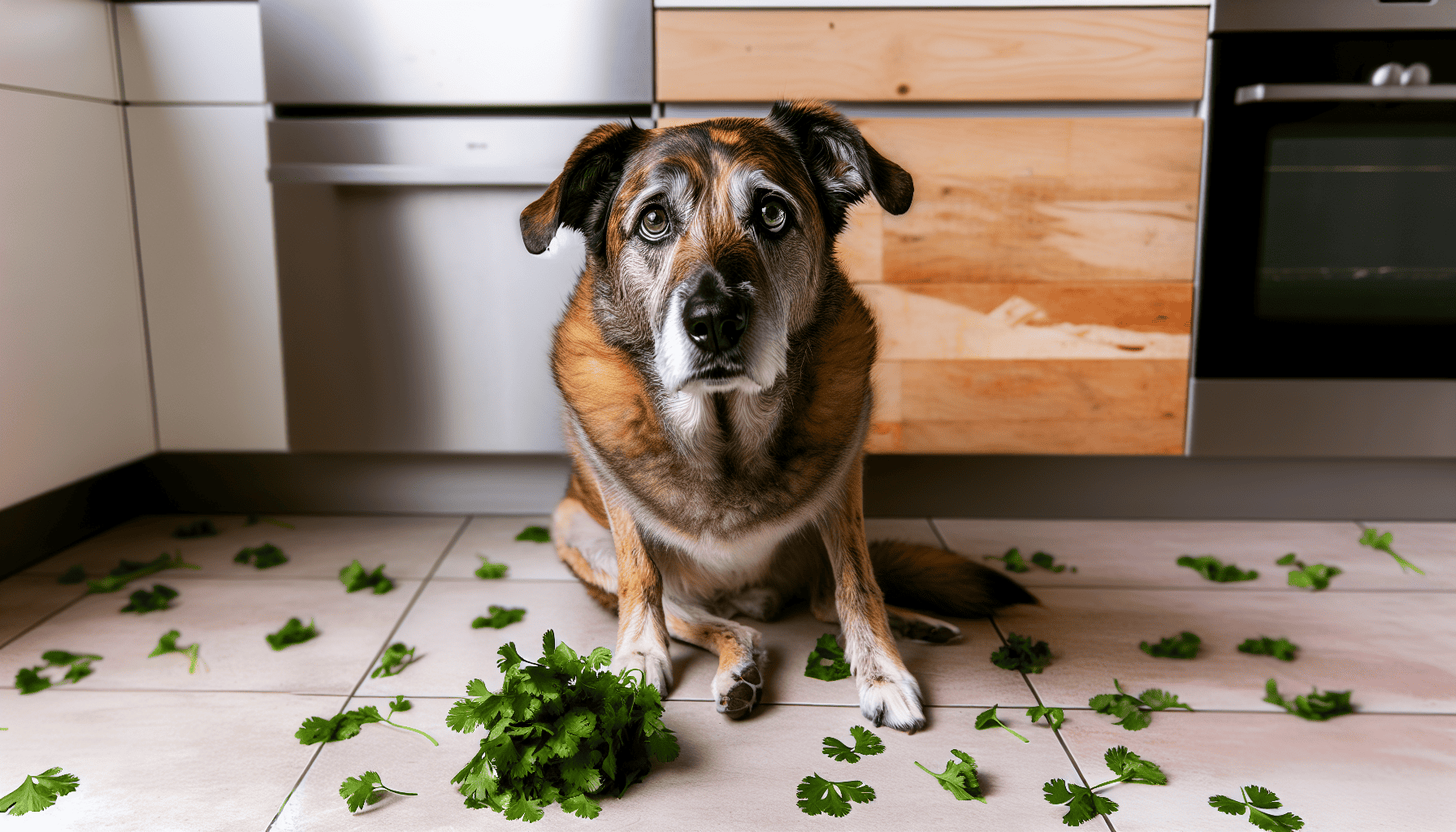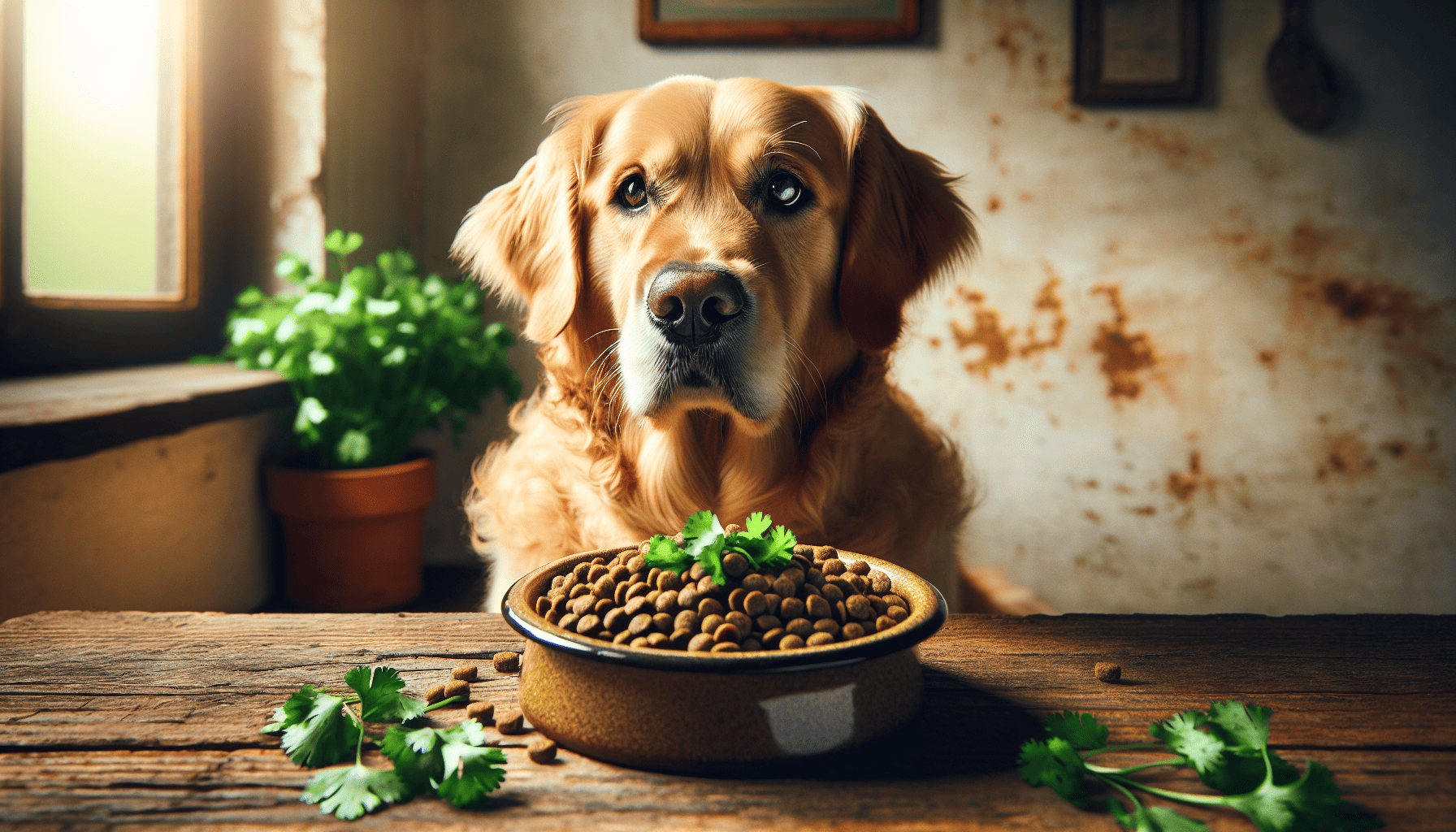If you’re wondering, ‘Can dogs eat cilantro?’ the answer is yes, dogs can safely consume cilantro in moderation. This herb is not toxic to our canine friends and possesses several potential health benefits which we will explore in this article. Whether you’re considering cilantro as a tasty treat or for its nutritional advantages, it’s essential to monitor how your dog reacts to this new addition to their diet. Read on to learn how to introduce cilantro to your dog and the precautions to keep in mind.
Table of Contents
Key Takeaways
Cilantro (coriander or Chinese parsley) is non-toxic to dogs and can be safely consumed in moderation, providing vitamins A, C, K, and minerals like magnesium and potassium, which support overall health including eye health and skin vitality.
While cilantro offers numerous health benefits, such as boosting the immune system and aiding digestion, it’s important to introduce it slowly to monitor for any adverse reactions, allergies, or stomach upset in individual dogs.
Pet owners should be mindful of potential dangers associated with cilantro, including allergic reactions, herbicide/pesticide contamination, and the risks of overconsumption. It’s advisable to seek veterinary care if adverse reactions occur and always moderate cilantro intake.
Cilantro and Canines: The Basics

Cilantro, also known as coriander or Chinese parsley, is a flavorful herb that we humans love to use in our recipes. But, does it hold a place in a dog’s diet? The answer is yes, but, like everything else, moderation is the key. This herb is not toxic to dogs, and offering it in controlled amounts can be a safe and enjoyable addition to a dog’s meals, making it a suitable dog cilantro treat.
However, not all dogs are the same. Some may relish the unique flavor of cilantro, while others may turn their noses up at it. Pet owners should carefully observe their dogs’ reactions when introducing this herb into their diet for the first time. If your dog eats cilantro without any adverse reactions, it can potentially become a beneficial part of their meals.
What is Cilantro?
Cilantro, known as coriander or Chinese parsley in some parts of the world, is a popular herb used in a variety of cuisines. Whether it’s a salsa, curry, or salad, cilantro can add a fresh and zesty flavor that enhances any dish. However, before you rush to add this herb to your dog’s food, it’s important to know what it is and whether it’s safe for your canine friend.
The good news is that cilantro is non-toxic and safe for dogs to consume in moderation.
Can Dogs Eat Cilantro Safely?
Yes, dogs can eat cilantro! But as with all foods, it’s essential to introduce it slowly and in small amounts. Why? Well, every dog is unique, and what suits one may not necessarily suit another. Some dogs might enjoy the strong, distinctive flavor of cilantro, while others might find it off-putting. So, when you first introduce cilantro to your dog’s diet, be prepared for a mixed bag of reactions.
As a pet owner, your primary concern should be your dog’s health. Therefore, when your dog eats cilantro for the first time, closely monitor its response. If your dog shows any signs of stomach irritation or food aversion after eating cilantro, it’s best to discontinue its use and consult your vet. Remember, what’s most important is that your dog enjoys its meals and stays healthy!
Health Advantages of Cilantro for Dogs

So, we’ve established that dogs can eat cilantro, but why should they? The answer lies in the numerous health benefits this humble herb offers. From its nutritional content to its ability to support digestion and boost the immune system, cilantro can be a beneficial addition to your dog’s diet.
Cilantro is packed with essential vitamins such as A, C, and K, which are vital for a dog’s eye health and skin vitality. Additionally, this herb provides valuable minerals like:
magnesium
calcium
potassium
manganese
These minerals strengthen bones and contribute to a dog’s overall structural health. But, the goodness doesn’t stop there! Cilantro is also rich in antioxidants, which can combat harmful free radicals, thus supporting a healthy canine immune system.
Beyond these primary health benefits, cilantro can contribute to better cellular health, provide a calming effect on anxious dogs, and even ease the pain associated with arthritis. With so many benefits packed into its tiny leaves, cilantro could be a great addition to your dog’s meals. But remember, moderation is key!
Nutrient-Rich Herb
Cilantro is a nutrient powerhouse for your dog. It’s high in vitamins A, C, and K, which are essential for maintaining your dog’s eye health and skin vitality. The minerals found in cilantro, like:
magnesium
calcium
potassium
manganese
Contribute to your dog’s health, particularly focusing on bone health and overall structural wellness. And let’s not forget the robust antioxidants in this herb, which can combat harmful free radicals in your dog’s body, supporting a healthy immune system.
So, including a moderate amount of cilantro in your small dogs’ diet could provide a substantial nutritional boost to their overall dog’s diet!
Digestive Support
Apart from being a nutritional powerhouse, cilantro may also enhance your dog’s digestion. This herb promotes the production of digestive enzymes, aiding in more efficient food breakdown and nutrient absorption. But that’s not all. Cilantro also possesses antifungal and antibacterial properties that can benefit a dog’s digestive system.
And for dogs with sensitive stomachs, fresh cilantro leaves can help ease an upset stomach and alleviate mild gastrointestinal issues. So, the next time your pooch has a tummy upset, a pinch of cilantro might just do the trick!
Immune System Boost
A strong immune system is crucial for your dog’s overall health and well-being. And guess what? Cilantro can help with that too! This herb is rich in vitamin C, a nutrient known for its immune-boosting properties. Additionally, the antioxidants present in cilantro can promote a robust immune system in your canine friend. Plus, the antibacterial and anti-fungal properties of cilantro provide an extra layer of protection against harmful infections. Talk about a herb with a punch!
Potential Dangers of Cilantro for Dogs

While cilantro can offer numerous benefits to your furry friend, it’s also important to be aware of its potential dangers. Like any food, cilantro can cause problems if consumed in excess or if your dog is allergic to it. Furthermore, environmental factors like exposure to herbicides and pesticides can pose additional risks.
So, while cilantro can be a tasty and nutritious addition to your dog’s diet, it’s always best to proceed with caution.
Allergic Reactions
Just like humans, dogs can develop allergies to certain foods, including herbs like cilantro. Although these reactions are not common, they can occur, particularly if your dog has never eaten cilantro before. Allergic reactions can cause a variety of symptoms, including itching and skin rashes, as well as vomiting or diarrhea..
If you notice any of these symptoms after introducing cilantro to your dog’s diet, it’s best to discontinue its use and consult your vet.
Herbicides and Pesticides
Cilantro, like any other plant, can be exposed to herbicides and pesticides, which, if ingested, can pose health risks to your dog. It is important to wash cilantro thoroughly before giving it to your dog. This ensures that any dirt or residue is removed, reducing the risk of your dog consuming harmful substances. This helps eliminate any residues of pesticides, dirt, or other potential contaminants, making it safe for dogs cilantro consumption.
By doing so, you can ensure that your dog gets to enjoy the benefits of cilantro without any of the risks.
Overconsumption
While cilantro can be a beneficial addition to your dog’s diet, too much of it can cause problems. Large amounts of cilantro may cause mild digestive problems in dogs, including upset stomach and diarrhea. This is particularly true if your dog consumes cilantro stems, which are harder to digest and can lead to gastrointestinal issues.
Even dogs that love the taste of cilantro should be monitored to prevent them from eating too much, especially if they have access to a herb garden. If your dog shows signs of stomach irritation or food aversion after eating cilantro, it’s best to discontinue feeding it and consult your vet about your dog’s stomach.
As with all things, balance and moderation are key when it comes to feeding cilantro to your dog.
Introducing Cilantro to Your Dog’s Meals

So, you’ve decided to try adding cilantro to your dog’s meals. That’s great! But, how should you go about it? The key is to start slowly and observe your dog’s reaction. Remember, it’s not just about whether dogs can eat cilantro, but also about whether they enjoy it and how their bodies respond to it.
When introducing cilantro to your dog’s diet, follow these guidelines:
Start with small amounts and gradually increase if your dog enjoys the flavor and shows no adverse reactions.
Use only the leaves, as the stems can cause digestive issues.
Monitor your dog closely for any changes in behavior or digestive health after introducing cilantro.
Starting Slowly
Introducing a new food to your dog’s diet should always be done cautiously, and cilantro is no exception. Begin by offering a small amount mixed with their regular food. This allows your dog to get used to the new flavor without overwhelming their palate. It also lets you observe their reaction to the new food.
You can gradually increase the amount of cilantro in your dog’s diet if they tolerate it well and show no adverse reactions. It’s important to monitor their response as you make adjustments.
Serving Ideas
You can serve cilantro to your dog in the following ways:
Mix it with their food
Chop it and sprinkle it on top as a garnish
Finely dice the leaves and sprinkle them over their regular food for a fresh burst of flavor
Incorporate cilantro into homemade treats for a nutritious and tasty surprise
Either way, too much cilantro can be a tasty and healthy addition to both human foods and their diet.
For example, a homemade dog treat recipe that includes cilantro involves mixing rolled oats, finely chopped cilantro, unsweetened applesauce, and water, and then baking the mixture until the treats are golden brown. Experiment with these ideas and see which dog food option your canine pal loves the most!
Cilantro Alternatives for Dogs

But what if your dog doesn’t like cilantro or can’t tolerate it well? Don’t worry, there are other herbs that can provide similar benefits and might be more to your dog’s liking.
Parsley, basil, and mint are all safe and beneficial herb alternatives to cilantro for dogs. These herbs offer a variety of flavors and health benefits, making them suitable substitutes for dogs that are not fans of cilantro.
Parsley
Parsley is a nutritious herb that offers health benefits to dogs, just like cilantro. It contains vitamins A and C, folic acid, and antioxidants. However, only curly parsley is safe for dogs, as other varieties may contain harmful toxins. It’s also important to note that pregnant dogs or dogs with kidney issues should avoid parsley due to its potential harmful effects in these specific conditions.
As a general rule of thumb, a dog can safely consume one tablespoon of parsley per twenty pounds of body weight.
Basil
Basil is another safe and flavorful herb for dogs. It can be lightly sprinkled on top of a dog’s regular food, adding a new dimension of flavor to their meals. Basil can also be used in homemade dog treats. However, while preparing these treats, remember to avoid garlic, which can be toxic to dogs.
Basil offers a different flavor profile from cilantro, and your dog might just prefer it!
Mint
Mint isn’t just a refreshing herb for humans; it also offers numerous health benefits for dogs. It contains vitamins A and C, iron, potassium, and fiber, all of which contribute to a dog’s overall health. Furthermore, menthol found in mint is known to help soothe upset stomachs and reduce gas and bloating in dogs.
Fresh mint leaves can be chopped finely and added directly to a dog’s food, or dried mint can be sprinkled over their meal or incorporated into homemade dog treats. And let’s not forget, mint is a natural breath freshener, making it a popular choice for combating doggy breath. However, mint, like cilantro, should be given in moderation to avoid stomach upset or any adverse effects.
Recognizing and Handling Cilantro Allergies in Dogs
While cilantro can be a healthy and tasty addition to your dog’s diet, it’s crucial to be vigilant for any signs of an allergic reaction. Dogs can develop allergies to certain foods, including herbs like cilantro.
If your dog shows signs of an allergic reaction after consuming cilantro, discontinue use and seek veterinary assistance immediately.
Identifying Allergic Reactions
Allergic reactions in dogs can manifest in various ways. If your dog is allergic to cilantro, they may exhibit symptoms such as:
itching
swelling
difficulty breathing
gastrointestinal issues like vomiting or diarrhea.
It’s essential to be aware of these signs and monitor your dog closely after introducing cilantro or any other new food to their diet.
What to Do If Your Dog Has an Allergic Reaction
In severe cases, such as difficulty breathing, excessive facial swelling, or collapse, it’s crucial to seek immediate veterinary care. Even for less severe reactions, if symptoms persist or worsen, don’t hesitate to consult your vet.
While waiting for veterinary help, you can apply a cold compress to mild swelling and inflammation for about 10 to 15 minutes. But remember, these first aid measures are only temporary solutions. Always consult a veterinarian for a proper diagnosis and treatment plan if your dog has an allergic reaction to cilantro or any other food.
Dental Care and Cilantro: Fresh Breath for Fido
We’ve talked about cilantro’s nutritional benefits and potential risks, but did you know that this herb can also contribute to your dog’s dental health? In fact, cilantro is known to help freshen a dog’s breath. But remember, while cilantro might help with bad breath, its effects are not long-term, and it should not be relied upon as the only solution for bad breath.
Cilantro for Fresh Breath
Cilantro contains natural properties that can help freshen a dog’s breath by masking unpleasant odors. So, if your dog has been struggling with bad breath, a sprinkling of cilantro on their meals could be a temporary solution. However, it’s important to note that while cilantro can freshen a dog’s breath, it is not a comprehensive solution for maintaining dental health.
Maintaining Good Dental Hygiene
While cilantro can temporarily freshen your dog’s breath, it’s not a substitute for regular dental care practices. Regular teeth brushing, providing dental chews, and professional cleanings are essential for maintaining your dog’s oral health. Dental problems or gum disease that contribute to bad breath in dogs need to be addressed promptly and professionally, as relying solely on cilantro for your dog’s breath freshness is insufficient.
Dental chews can also contribute significantly to canine oral health through their mechanical action on teeth, an effect that cilantro does not provide. So, while cilantro can be a complementary freshener, a comprehensive dental care routine is necessary for maintaining a dog’s oral health.
Summary
In conclusion, cilantro can be a beneficial addition to your dog’s diet, providing a variety of health benefits including nutritional richness, digestive support, and immune system boost. However, it’s important to introduce cilantro slowly to your dog’s meals, observe their reaction, and be aware of potential dangers like allergies and herbicide/pesticide contamination.
While cilantro can freshen your dog’s breath, it’s not a long-term solution or a substitute for regular dental care practices. And if your dog doesn’t take to cilantro, alternatives like parsley, basil, and mint can be beneficial substitutes. As always, your dog’s health and happiness should be your top priority. So, whether you choose to introduce cilantro or any other new food to your dog’s diet, do so thoughtfully, responsibly, and with your vet’s guidance.
Frequently Asked Questions
Is cilantro bad for dogs?
Cilantro is generally safe for dogs, and it can even provide essential nutrients like vitamins A, C, and K, as well as minerals such as potassium and manganese. Just make sure to feed it in moderation and avoid the stems.
What herbs are dogs not allowed to eat?
Dogs are not allowed to eat allspice, bay leaf, cloves, curry, hops, marjoram, mustard seed, paprika, garlic, onions, scallions, chives, and cayenne. They may not enjoy the taste of cayenne and it’s best to avoid it altogether.
Can dogs eat cilantro and parsley?
Yes, dogs can eat cilantro and parsley in moderation as they are generally considered safe for dogs, even those with pancreatitis.
What are the health benefits of cilantro for dogs?
Cilantro offers numerous health benefits for dogs, including nutritional richness, digestive support, and immune system boost. It can be a great addition to your dog’s diet for overall health and well-being.
How should I introduce cilantro to my dog’s diet?
Introduce cilantro to your dog’s diet by adding small quantities and monitoring for adverse symptoms to ensure tolerance.





